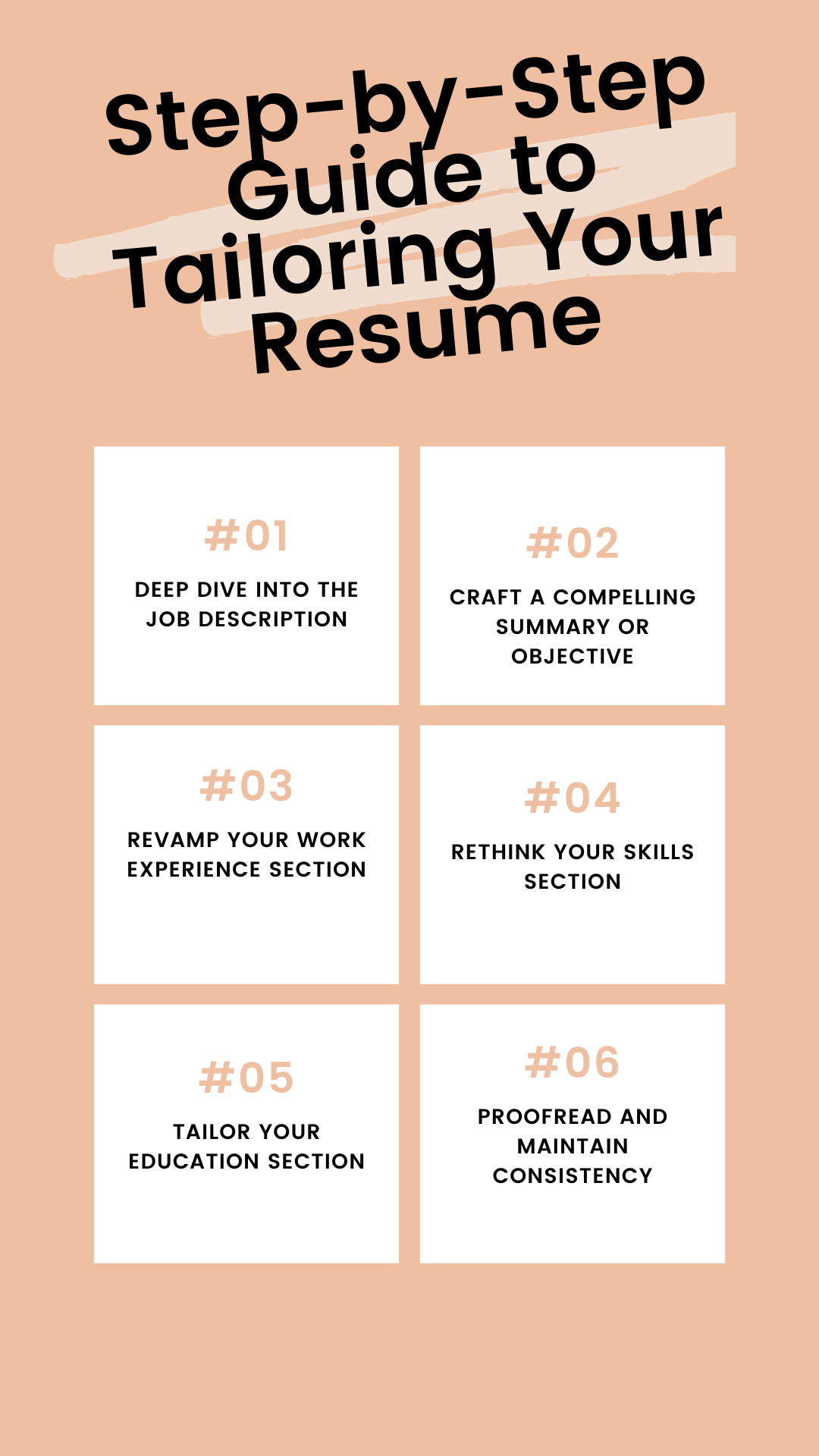If you are a college student or a fresher stepping into the professional world, creating a well-structured resume is your first step to success. A polished and ATS-friendly resume can…

How To Tailor Your Fresher’s Resume For Different Job Applications?
In today’s competitive job market, a generic resume won’t get you far. Applicant Tracking Systems (ATS) scan resumes for specific keywords before a human ever lays eyes on them. Even if you bypass the ATS, a resume that doesn’t speak directly to the job description lands in the “no” pile. The solution? Tailoring your resume for each job application.
This guide equips you with the knowledge and strategies to craft targeted resumes that land you interviews.
Why Tailor Your Freshers Resume?
Imagine a hiring manager sifting through hundreds of resumes. What catches their eye? Resumes that showcase a clear match between the candidate’s skills and the job requirements.
Tailoring your resume demonstrates:
- You’ve taken the time to grasp the specific needs and responsibilities of the position.
- You highlight the qualifications that make you the perfect fit.
- You tailor your language to match the company’s culture and the job description.
Step-by-Step Guide to Tailoring Your Resume
Here’s a breakdown of the key steps involved in tailoring your resume for each job application:
Deep Dive into the Job Description:

- Treat the job description as your blueprint. Carefully read and analyze the requirements, responsibilities, and desired skills.
- Identify the most frequently mentioned keywords and skills. These are the golden nuggets you’ll integrate throughout your fresher’s resume.
- Pay attention to the tone and language used in the description. Mirroring this style demonstrates a strong understanding of the company culture and its role.
Craft a Compelling Summary or Objective:
- A well-written resume summary or objective section can be a game-changer.
- Use keywords from the job description to highlight your most relevant skills and experiences.
- Briefly showcase your career goals and how they align with the specific position.
Revamp Your Work Experience Section:
- Don’t simply copy and paste your experience across all resumes.
- Focus on the accomplishments and responsibilities most relevant to the job you’re applying for.
- Quantify your achievements whenever possible. Use numbers, percentages, or metrics to demonstrate the impact you’ve made in previous roles.
- Instead of just stating “managed social media accounts,” quantify it as “Increased social media engagement by 20% through targeted content campaigns.”
Rethink Your Skills Section:
- Prioritize the skills section by listing the most relevant skills for the specific job at the top.
- Don’t just list generic skills. Use keywords from the job description and showcase your proficiency level (e.g., proficient in Adobe Photoshop).
- Consider including a mix of hard skills (technical abilities) and soft skills (interpersonal qualities).
Tailor Your Education Section:
- If you have extensive work experience, you can keep the education section concise.
- Highlight any relevant coursework, certifications, or projects that demonstrate your qualifications for the specific job.
Proofread and Maintain Consistency:
- Typos and grammatical errors can be a major turn-off for hiring managers. Meticulously proofread your resume for any mistakes.
- Maintain consistency in formatting and layout throughout your resume. A professional and clean presentation is essential.
By following these steps and investing the time to tailor your resume for each job application, you’ll significantly increase your chances of getting noticed by hiring managers. Remember, your resume is your marketing tool – use it strategically to showcase your value and land your dream job.
FAQs on Tailoring The Resume For Different Job Applications
How much time does it take to tailor a resume?
Tailoring time varies. A simple revision might take 15 minutes, while a complete overhaul could take an hour. The key is to have a strong base resume to work from.
Can I use a resume builder to tailor my resume?
Resume builders can be a helpful starting point, but for true tailoring, it’s best to customize the text yourself to strategically incorporate relevant keywords.
What if I don’t have all the skills listed in the job description?
Focus on the most relevant skills you possess. Highlight transferable skills and your eagerness to learn.
Should I tailor my resume for every single application?
Ideally, yes! Even slight tailoring shows effort and increases your chances of getting noticed, especially for competitive roles.
How many versions of my resume should I have?
It depends on your career goals. Having 3-5 tailored resumes for different industries or job types is a good starting point.
Is it okay to lie on my resume to fit the job description?
Absolutely not. Honesty and integrity are crucial. Focus on highlighting transferable skills and your potential to learn.
What if the job description doesn’t mention many skills?
Research the company and industry to identify relevant skills. Tailor your resume to showcase your problem-solving abilities and eagerness to learn.
How can I tell if my tailored resume is effective?
Track your application results. If you’re not getting interviews, it might be time to refine your tailoring strategy.
Latest Posts
How to Write a Resume Headline for Freshers
Your resume headline is the first thing a recruiter will see, so it’s important to ensure it’s strong and attention-grabbing. Even if you are new to the job market and…
How to Make a BCom Fresher Resume?
Graduating with a Bachelor of Commerce (BCom) degree opens up a world of opportunities in the business sector. However, landing that first job can be challenging, especially when you’re competing…
About Me in Resume for Freshers: How to Write, Examples
The journey from college to your first job is an exciting but often challenging transition. As a fresher or college student preparing to step into the professional world, your resume…
Best CV Formats for Freshers: Simple, Professional & Job-Winning Templates
Creating an effective CV (Curriculum Vitae) is the first step towards landing your dream job or internship as a fresh graduate. Your CV is your initial introduction to potential employers…
Popular Posts
Best CV Formats for Freshers: Simple, Professional & Job-Winning Templates
Creating an effective CV (Curriculum Vitae) is the first step towards landing your dream job or internship as a fresh graduate. Your CV is your initial introduction to potential employers…
How to Write Mail for Job Application – Explained
A job application email is a professional email that you send to a potential employer to express your interest in a job opening. It is typically accompanied by your resume…
250+ Group Discussion Topics for Interviews with Expert GD Tips
Group discussions (GD) are a critical aspect of the interview process for college students and freshers. They are commonly used in campus placements, competitive exams, and job interviews to evaluate…
How to Write a Job Application Letter – Tips, Format, and Examples
When it comes to applying for your first job, making a great first impression is crucial. As a recent graduate, you might feel a little intimidated by the idea of…
Latest Mechanical Engineering Interview Questions and Answers
Entering the world of mechanical engineering as a fresher is an exciting journey, but the path to success often involves navigating through challenging interviews. In this guide, we’ve curated a…
